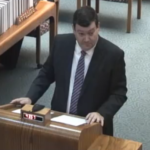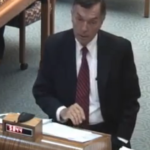The Kansas Supreme Court held oral arguments last month in the on-going, seemingly endless Gannon v. State of Kansas school finance litigation. In question is the adequacy of funding to K-12 education across the state. Despite that fact that the Court’s decision has a potentially seismic impact on not only funding to education, but also to other state services and even the tax structure of the state, little has been reported by the news media. This article, Part 1, will summarize the proceedings from the perspective of the state solicitor, the plaintiff’s attorney and that of the justices. Part 2 will provide reaction and an in-depth analysis of the arguments and justices’ responses.
At the epicenter of the oral arguments and current round of litigation are the Rose standards. In a previous Gannon ruling by the Supreme Court, it declared the education finance system is “reasonably calculated,” in other words adequately funded, when students are meeting or exceeding the Rose standards.
 The attorney for the State, solicitor general Stephen McAllister, was first to address the Court. Here is the summary of his overarching argument:
The attorney for the State, solicitor general Stephen McAllister, was first to address the Court. Here is the summary of his overarching argument:
- There has been an increase in the amount of funding to education since 2009.
- Kansas is doing well in terms of outcomes compared to other states in the nation.
- Therefore, the Rose standards have been met and the court has no reason to order more money to K-12 education.
- Furthermore, the Court should give deference to the Legislature for making funding decisions.
Alan Rupe, the attorney for the plaintiffs, addressed the Court next. Rupe’s position was the polar opposite of the State’s. His arguments:
- Student outcomes are unacceptably low. He cited NAEP data to make his case.
- Therefore, Rose standards have not been met and the Court should intervene.
- The Court should follow previous cost studies and order an additional $800 million to K-12 funding.
 The justices interjected frequently throughout both presentations. Although impossible to tell the Court’s opinion from how they responded, their questions and comments seemed to lean toward the idea that:
The justices interjected frequently throughout both presentations. Although impossible to tell the Court’s opinion from how they responded, their questions and comments seemed to lean toward the idea that:
- Rose standards have been addressed/defined/measured by the State Board of Education.
- More money necessarily leads to higher outcomes.
In the end, Chief Justice Lawton Nuss gave no hint as to when a “remedy” as he called it would be forthcoming. However, he queried both attorneys as to how long the Legislature should have to address the issue through a new school finance law. (A new finance law is slated to be crafted during the 2017 legislative session to replace the block grant system, which sunsets at the end of the current school year.) McAllister suggested and Rupe hesitantly agreed that the Legislature should have the entirety of the session to do so.
Will the court act prior to that? Who knows?
Part 2 will focus on:
- The weakness of the case presented by the State.
- How the plaintiffs’ attorney is half-right and half-wrong.
- The complete lack of understanding of education issues and the distinctive liberal leanings on the part of the justices.
Stay tuned!




